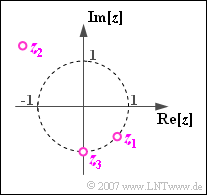Exercise 1.3: Calculating with Complex Numbers
From LNTwww
The diagram to the right shows some points in the complex plane, namely
- $$z_1 = {\rm e}^{\hspace{0.05cm}-{\rm j} \hspace{0.05cm}\cdot \hspace{0.05cm} 45^{ \circ}}, $$
- $$z_2 = 2 \cdot{\rm e}^{\hspace{0.05cm}{\rm j} \hspace{0.05cm}\cdot \hspace{0.05cm}135^{ \circ}},$$
- $$z_3 = -{\rm j} .$$
In the course of this task, the following complex quantities will be considered:
- $$z_4 = z_2^2 + z_3^2,$$
- $$z_5 = 1/z_2,$$
- $$z_6 = \sqrt{z_3},$$
- $$z_7 = {\rm e}^{\hspace{0.05cm}z_2},$$
- $$z_8 = {\rm e}^{\hspace{0.05cm}z_2} + {\rm e}^{\hspace{0.05cm}z_2^{\star}}.$$
Notes:
- This exercise belongs to the chapter Calculating with Complex Numbers.
- The topic of this task is also covered in the (German language) learning video
Rechnen mit komplexen Zahlen ⇒ "Arithmetic operations involving complex numbers".
Questions
Solution
(1) Correct are the solutions 1 and 2:
- The following applies with Euler's theorem:
- \[2 \cdot z_1 + z_2 = 2 \cdot \cos(45^{ \circ}) - 2 \cdot {\rm j}\hspace{0.05cm}\cdot \hspace{0.05cm} \sin(45^{ \circ})- 2 \cdot \cos(45^{ \circ}) + 2\cdot {\rm j} \cdot\sin(45^{ \circ}) = 0.\]
- The second option is also correct, because
- \[z_1^{\star} \cdot z_2 = 1 \cdot{\rm e}^{{\rm j}\hspace{0.05cm}\cdot \hspace{0.05cm} 45^{ \circ}} \cdot 2 \cdot{\rm e}^{{\rm j}\hspace{0.05cm}\cdot \hspace{0.05cm} 135^{ \circ}} = 2 \cdot{\rm e}^{{\rm j}\hspace{0.05cm}\cdot \hspace{0.05cm} 180^{ \circ}}= -2.\]
- In contrast, the third option is wrong. The division of \(z_1\) and \(z_2\) yields:
- \[\frac{z_1}{z_2} = \frac{{\rm e}^{-{\rm j}\hspace{0.05cm}\cdot \hspace{0.05cm} 45^{ \circ}}}{2 \cdot{\rm e}^{{\rm j} \hspace{0.05cm}\cdot \hspace{0.05cm}135^{ \circ}}} = 0.5 \cdot{\rm e}^{-{\rm j}\hspace{0.05cm}\cdot \hspace{0.05cm} 180^{ \circ}}= -0.5.\]
- The multiplication by \(z_3 = -{\rm j} \) leads to the result ${\rm j}/2$, i.e. to a purely imaginary quantity.
(2) The square of \(z_2\) has the magnitude \(|z_2|^{2}\) and the Phase \(2 \cdot \phi_2\):
- \[z_2^2 = 2^2 \cdot{\rm e}^{{\rm j}\hspace{0.05cm}\cdot \hspace{0.05cm} 270^{ \circ}}= 4 \cdot {\rm e}^{-{\rm j}\hspace{0.05cm}\cdot \hspace{0.05cm} 90^{ \circ}}=-4 \cdot {\rm j}.\]
- Accordingly, the following applies to the square of \(z_3\):
- \[z_3^2 = (-{\rm j})^2 = -1.\]
- Thus \(x_4 =\underline{ –1}\) and \(y_4 = \underline{–4}.\)
(3) By applying the division rule one obtains:
- \[z_5 = {1}/{z_2} = \frac{1}{2 \cdot{\rm e}^{{\rm j}\hspace{0.05cm}\cdot \hspace{0.05cm} 135^{ \circ}}}= 0.5 \cdot{\rm e}^{-{\rm j}\hspace{0.05cm}\cdot \hspace{0.05cm} 135^{ \circ}} = 0.5 \cdot \big[ \cos (- 135^{ \circ}) + {\rm j} \cdot \sin (- 135^{ \circ})\big]\]
- \[\Rightarrow \ x_5 = - {\sqrt{2}}/{4}\hspace{0.15cm}\underline{= -0.354},\hspace{0.5cm} y_5 = x_5 \hspace{0.15cm}\underline{= -0.354}.\]
(4) The given relation for \(z_6\) can be transformed as follows: \(z_6^2 = {z_3} = {\rm e}^{-{\rm j}\hspace{0.05cm}\cdot \hspace{0.05cm} 90^{ \circ}}.\)
- We can see that there are two possibilities for \(z_6\) that satisfy this equation:
- \[z_6 \hspace{0.1cm}{\rm (1.\hspace{0.1cm} solution)}\hspace{0.1cm} = \frac{z_2}{2} = 1 \cdot {\rm e}^{{\rm j} \hspace{0.05cm}\cdot \hspace{0.05cm}135^{ \circ}} \hspace{0.2cm}\Rightarrow \hspace{0.2cm} \phi_6 \hspace{0.15cm}\underline{= 135^{ \circ}}, \]
- \[z_6 \hspace{0.1cm}{\rm (2.\hspace{0.1cm} solution)}\hspace{0.1cm} = {z_1} = 1 \cdot {\rm e}^{-{\rm j} \hspace{0.05cm}\cdot \hspace{0.05cm}45^{ \circ}} \hspace{0.2cm}\Rightarrow \hspace{0.2cm} \phi_6 \hspace{0.15cm}\underline{=-45^{ \circ}}.\]
(5) The complex quantity \(z_2\) in real part/imaginary part representation is:
- \[z_2 = x_2 + {\rm j} \cdot y_2 = -\sqrt{2} + {\rm j} \cdot\sqrt{2}.\]
- This results in the following for the complex exponential function:
- \[z_7 = {\rm e}^{-\sqrt{2} + {\rm j}\hspace{0.05cm}\cdot \hspace{0.05cm}\sqrt{2}}= {\rm e}^{-\sqrt{2} } \cdot \big[ \cos (\sqrt{2}) + {\rm j} \cdot \sin (\sqrt{2})\big].\]
- Thus with \({\rm e}^{-\sqrt{2} } = 0.243, \hspace{0.4cm} \cos (\sqrt{2}) = 0.156, \hspace{0.4cm} \sin (\sqrt{2}) = 0.988\) one obtains:
- \[z_7 = 0.243 \cdot \left( 0.156 + {\rm j} \cdot 0.988\right) \hspace{0.15cm}\underline{= 0.038 + {\rm j} \cdot 0.24}.\]
(6) Starting from the result of subtask (4) one obtains for \(z_8\):
- \[z_8 = {\rm e}^{-\sqrt{2} } \cdot \big[ \cos (\sqrt{2}) + {\rm j} \cdot \sin (\sqrt{2}) + \cos (\sqrt{2}) - {\rm j} \cdot \sin (\sqrt{2})\big] = 2 \cdot {\rm e}^{-\sqrt{2} } \cdot \cos (\sqrt{2}) = 2 \cdot x_7 \hspace{0.5cm}\Rightarrow \hspace{0.5cm} x_8 \hspace{0.15cm}\underline{= 0.076}, \hspace{0.4cm}y_8\hspace{0.15cm}\underline{ = 0}.\]
